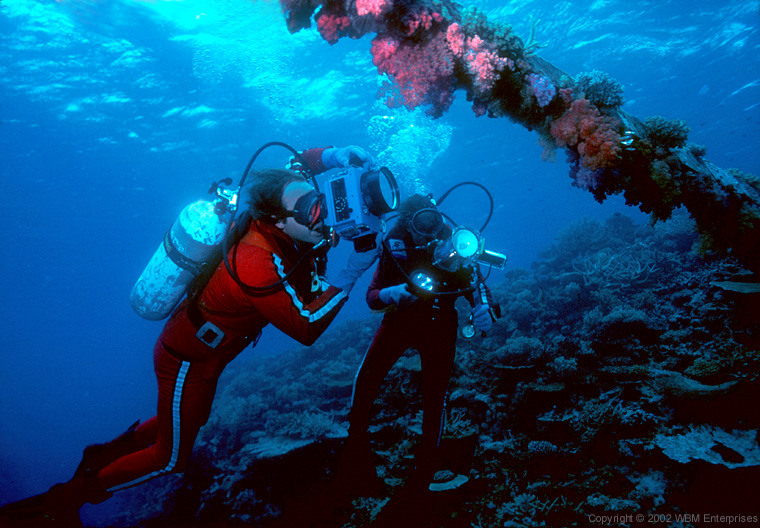
Mimi and Walt Miller photograph soft corals on an underwater girder, Taveuni, Fiji - Depth 35 feet
(Photo by Carl Roessler)

Mimi and Walt Miller photograph soft corals on an underwater girder, Taveuni, Fiji - Depth 35 feet
(Photo by Carl Roessler)
About The Images
Midrange and close-up Underwater photographs were taken with a Nikon F2 camera and MD-2 motor drive in an Oceanic Products Hydro-35 housing. Three lenses were used, the 55mm Micro-Nikkor, the 105mm Micro-Nikkor, and 35mm Nikkor, each behind a flat port . For wide-angle photography, we used a 24mm Nikkor lens in the same housing, but with a dome port. We also a used a Nikonos 3 with Nikon 15mm underwater lens. We made use of a variety of strobes, among these being the Oceanic Products 2001 and 2003, and the Matzkanin 105. In the past, we generally used Kodacrome 64, chosen because it stood up well to a variety of environmental conditions. Now, we generally use Fujichrome, either Velvia or Provia. Our approach to underwater photography hinges on teamwork and communication. One partner generally handles the housed camera, the other a Nikonos III on a platform with attached strobe. The strobe is fitted with a long connecting cord that is capable of underwater attachment to either camera, so that we have both closeup and wide-angle capabilities. We also use a variable power underwater torch as an aid to focusing. Before the dive, it is helpful to balance the proposed subject size with lens focal length, projected camera-to-subject distance, flash distance, and flash coverage. This is especially important for mid-range subjects. In deserts and mountains, our favorite films are Fujicrome Velvia and Provia. In action shots, have had excellent results when we push the Provia one stop. On the topic of film, we use a variety for special purposes. Sometimes it is print film, generally it is slide film. We see film as just one more dimension in the process of obtaining a final image. In general, we try to shoot in what is called by Charles Campbell the "Golden Hours"; that is, up to two hours after sunrise, and two hours or less before sunset. We like the light at these times, and in some cases, the wind seems less of a problem. Improvization is great, but we always carry the heaviest tripod we can manage for the day's planned shooting. When we can, we carry two tripods, so that we can work a subject from as many viewpoints as possible. The heaviest lens we routinely carry is the Nikkor 300mm F4.5 EDIF with 1.4x Teleconverter. |